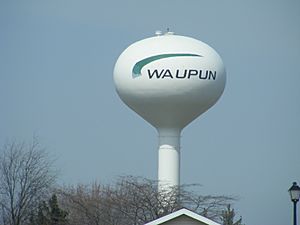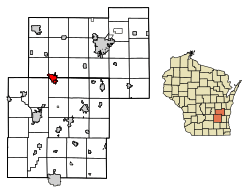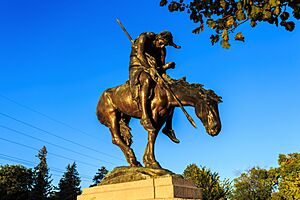Waupun, Wisconsin facts for kids
Quick facts for kids
Waupun, Wisconsin
|
|
|---|---|

Waupun water tower
|
|
| Nickname(s):
City of Sculptures, Prison City
|
|

Location of Waupun in Fond du Lac County, Wisconsin.
|
|
| Country | |
| State | |
| County | Dodge, Fond du Lac |
| Area | |
| • Total | 4.68 sq mi (12.12 km2) |
| • Land | 4.62 sq mi (11.97 km2) |
| • Water | 0.06 sq mi (0.16 km2) |
| Elevation | 892 ft (272 m) |
| Population
(2020)
|
|
| • Total | 11,344 |
| • Density | 2,455.4/sq mi (948.0/km2) |
| Time zone | UTC-6 (Central (CST)) |
| • Summer (DST) | UTC-5 (CDT) |
| ZIP code |
53963
|
| Area code(s) | 920 |
| FIPS code | 55-84425 |
| GNIS feature ID | 1576324 |
Waupun is a city located in the state of Wisconsin, USA. It sits across two counties: Dodge and Fond du Lac. In 2020, about 11,344 people lived there. Waupun is sometimes called the "City of Sculptures" because of the many artworks found around town. It's also known as "Prison City" because it's home to a large state prison.
Contents
History of Waupun
How Waupun Started
Waupun was founded in 1839 by Seymour Wilcox. He was the first person to settle along the Rock River in this area. John Bannister, a surveyor, had told him the Rock River Valley was very beautiful and fertile.
Wilcox explored the land in late 1838. In February 1839, he returned with two men, John N. Ackerman and Hiram Walker. They were interested in the strong river and good land. They quickly built a small shelter and then a proper cabin for Wilcox's family. Wilcox went back to Green Bay to bring his family. They arrived in Waupun on March 20, 1839.
The name Waupun comes from the Ojibwe word "Waubun." This word means "the east," "the morning," or "dawn of day." The city was originally meant to be spelled "Waubun." However, the state of Wisconsin made a spelling mistake, and the name was never changed.
Early Days of the City
The first town election happened in 1842 at the Wilcox home. Only eleven votes were cast back then. Fifteen years later, when Waupun became a village, 323 votes were cast in its first election. Because the village grew steadily, it became a city on March 15, 1878. John N. Ackerman was chosen as the first city mayor.
In 1851, Waupun was chosen as the location for the State Penitentiary. This was because there was a lot of limestone nearby, which was good for building. The main prison building was finished in 1854 and is still used today.
The Milwaukee & Horicon Railroad reached Waupun in 1856. This railroad line was later sold and became part of "The Milwaukee Road." This company served Waupun until 1980. After that, the line was sold to Wisconsin and became the Wisconsin & Southern Railroad.
The Waupun Library Association started in 1858. William Euen and Edwin Hillyer helped create it. Hillyer managed the library from his insurance office for 37 years without pay. In 1895, the city took over the library. It moved to a room in the Whiting Theater. In 1900, the Waupun Women's Club helped make it a free public library. The Waupun Carnegie Library was built in 1904 with money from Andrew Carnegie. This building is now the Waupun Heritage Museum. A new library building was built in 1968, which is the current Waupun Public Library.
In 1847, the Town of Waupun had a population of 956 people. By 1875, the village of Waupun had grown to 1,867 people.
Waupun During World War II
In 1945, Waupun was chosen to host a German prisoner of war (POW) camp. Even though some people didn't like the idea, the camp was built next to a canning factory. The prisoners were brought to Wisconsin to help with a shortage of workers. There were about 200 POWs at the Waupun camp. They worked for local factories and farms, helping with food production.
Geography and Nature
Waupun is located at 43°37′54″N 88°44′9″W / 43.63167°N 88.73583°W. The city covers about 4.68 square miles (12.12 square kilometers). Most of this area is land, with a small amount of water.
The land in Waupun is moderately hilly. Its lowest point is about 870 feet (265 meters) at the Rock River. The highest point is about 941 feet (287 meters) above sea level.
Waupun is very close to the Horicon Marsh. This is the largest cattail marsh in the United States. It's a great place to watch wildlife. The city is a main entry point for visiting the Horicon Wildlife Refuges.
Fond du Lac County Park is on the edge of Waupun. This park has a preserved section of old-growth forest. This type of forest once covered a huge area of Southern Wisconsin. The park also offers camping for visitors.
People and Population
| Historical population | |||
|---|---|---|---|
| Census | Pop. | %± | |
| 1860 | 1,736 | — | |
| 1870 | 1,935 | 11.5% | |
| 1880 | 2,353 | 21.6% | |
| 1890 | 2,757 | 17.2% | |
| 1900 | 3,185 | 15.5% | |
| 1910 | 3,362 | 5.6% | |
| 1920 | 4,440 | 32.1% | |
| 1930 | 5,768 | 29.9% | |
| 1940 | 6,798 | 17.9% | |
| 1950 | 6,725 | −1.1% | |
| 1960 | 7,935 | 18.0% | |
| 1970 | 7,946 | 0.1% | |
| 1980 | 8,132 | 2.3% | |
| 1990 | 8,207 | 0.9% | |
| 2000 | 10,718 | 30.6% | |
| 2010 | 11,340 | 5.8% | |
| 2020 | 11,344 | 0.0% | |
| U.S. Decennial Census | |||
Population in 2020
In 2020, Waupun had a population of 11,344 people. This means there were about 2,455 people per square mile. There were 3,863 homes in the city.
The population was made up of different groups. About 80.7% of people were White. About 12.8% were Black or African American. Other groups included Native American, Asian, and people of two or more races. About 4.8% of the population was Hispanic or Latino.
The average income for a household in Waupun was about $55,621. For families, it was about $67,078. About 7.7% of all people in Waupun lived below the poverty line. This included 7.1% of those under 18 years old. Most adults (84.7%) had finished high school or higher. About 16.3% had a bachelor's degree or more.
Population in 2010
In 2010, Waupun had 11,340 people living there. There were 3,485 households. About 30.8% of households had children under 18. Many households (50.1%) were married couples.
The average age in Waupun was 36.4 years. About 17.6% of residents were under 18. About 61.0% of the population was male and 39.0% was female.
Getting Around Waupun
U.S. Highway 151 goes around Waupun, with four exits into the city. The old route of Highway 151 is now called Business Highway 151. Other state highways like WI 26, WI 49, and Wisconsin 68 also pass through Waupun. Several county highways serve the area too. The city is also served by the Wisconsin and Southern Railroad.
Schools in Waupun
Waupun is part of the Waupun Area School District. This district includes several schools:
- SAGES (School for Agriculture and Environmental Studies), located in Fox Lake.
- Meadow View Primary
- Rock River Intermediate
- Waupun High School
All schools except SAGES are located within Waupun. There is also a private school in the city called Central Wisconsin Christian High School.
Waupun's Economy
Waupun has been home to several important businesses. Alto Dairy Cooperative, a dairy company owned by farmers, was sold in 2008.
National Rivet, a company that makes rivets (a type of fastener), has been in Waupun for over 90 years. Its related company, the Shaler Company, was also based there.
Culture and Art

The City of Sculpture
Waupun is famous for its collection of outdoor sculptures. These artworks were created by Clarence Addison Shaler. He was a local manufacturer, inventor, and sculptor. Some of his famous sculptures include "The Dawn of Day," "Who Sows Believes in God," "The Pioneers," and "The Recording Angel."
A bronze copy of the well-known End of the Trail statue by James Earle Fraser is in Shaler Park. Shaler asked for this copy to be made in 1926. The statue shows a Native American person slumped on a horse. It represents the challenges faced by Native American people. It was officially placed in the park on June 23, 1929.
Notable People
- Frank L. Bacon, Wisconsin State Representative
- Thomas Bowen, Wisconsin State Senator
- Henry Waldo Coe, frontier physician and politician
- Harriet L. Cramer, newspaper publisher
- Glenn Robert Davis, U.S. Representative
- Fond du Lac County Jane Doe, unidentified murder victim interred at the Cattaraugus Cemetery, eventually identified as Amy Yeary
- Marcus Domask, basketball player
- Yasmin Farooq, 1996 Olympian (rowing cox)
- Joe Hauser, baseball player
- Hans Christian Heg, highest ranking Wisconsin soldier to die in the American Civil War
- Edwin Hillyer, Wisconsin State Representative
- Fred H. Hildebrandt, U.S. Representative from South Dakota
- Orville W. Mosher, Wisconsin State Senator
- Tom Mullica, magician and comedian
- Magdalen Redman, All-American Girls Professional Baseball League player
- David F. Simpson, Minnesota Supreme Court justice
- Oliver Smith, stage designer
- John van Hengel, Food Bank founder
- Harriet Ware, pianist and composer
- Ferdinand T. Yahr, Wisconsin State Senator
- Chauncey W. Yockey, Wisconsin State Representative
Images for kids
-
Former Waupun Public Library, now a museum, registered historic place.
See also
 In Spanish: Waupun (Wisconsin) para niños
In Spanish: Waupun (Wisconsin) para niños






